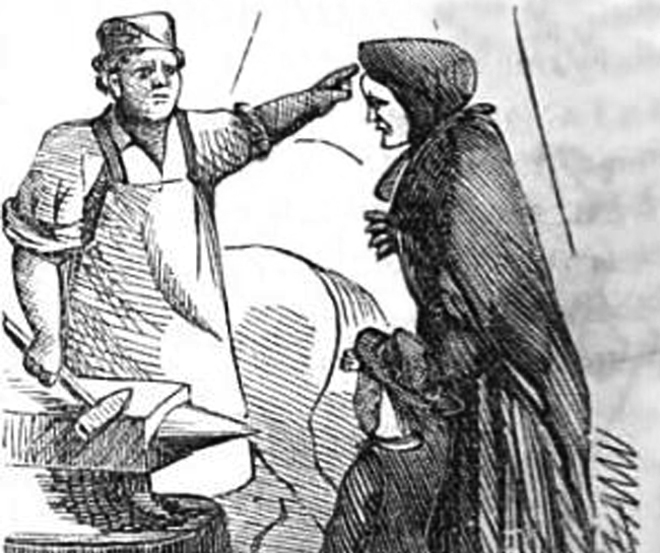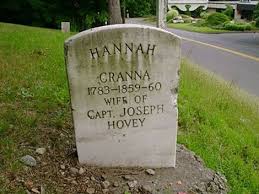This article was published by the Newtown Bee originally on 10/30/2011. You can see the original online at The Patch.

From the first witch hanging in the country to a plethora of Wicca shops in Western Connecticut, Connecticut’s witches are here to stay.
The spellbinding history of witches in Connecticut began when the first witch was hung in Hartford in 1647. In less than twenty years, 43 people in CT were accused and tried of witchcraft, which set the stage for Salem’s hysteria, according to a Ct.gov website. But the end of the punishments didn’t mean the end of witches in Connecticut, and in fact, it was just the beginning.
Local Witches

While there may have been others, the most famous witches in this area were Moll Cramer of Woodbury and Hannah Cranna of Monroe. Legend has it that both suffered wrathful tempers and caused woe unto those who dared to cross them. Both Cramer and Hannah Cranna made demands on their neighbors, who fearfully obliged. Cothren wrote that when Cramer was denied a piece of pork by a neighbor, all of their swine took ill and never fattened enough to be eaten. Cothren wrote, “If she visited a house where spinning was going on, the band of the wheel would fly off, the thread would break, the flyers would become disengaged or some unpleasant misfortune would occur during her stay.”
Hannah Cranna, whose married name had been Hovey, “surveyed her domain from a rock seat still found on the edge of Cutlers Farm Road,” according to the Monroe Historical Society website. Like Cramer, Hannah manipulated her nervous neighbors into giving her whatever she wanted. A woman who made pies once refused Cranna the best one, and was never able to make pies again. When passer-bys made fun of her powers, their cart fell apart after they passed her, the Monroe website stated. According to the legend, “The nuts loosened on the cart, the wheels came off, and the oxen ran away, leaving the men looking in despair. The men headed for home and it was days before the oxen were found.”
Both witches were thought to be responsible for weather. In the midst of a drought, a distraught farmer approached Hannah and begged her to relieve the dried fields and parched wells. The Historical Society wrote that Cranna promised the farmer that if he believed in her, his request would be granted. The following day the village was rewarded with heavy thunderstorms. While temperate weather was the norm when Moll was residing in Woodbury, in Off the Beaten Path Connecticut, authors David Ritchie, Tom Bross, Deborah Ritchie, Joan Bross, wrote, “After she disappeared without a trace, Woodbury was hit by a series of destructive storms, and even today old-timers speak of needing a Moll Cramer storm after a summer dry spell.”

While no one knows what happened to Moll Cramer, Monroe residents may pass Cranna’s white gravestone daily as it sits on a ridge along busy Spring Hill Road.
Today’s Witchcraft
While the witches of the past were feared because of their perceived misuse of their powers, today’s witches use their powers with more responsibility. Mary Kimball, former president of the Connecticut Wiccan and Pagan Network, has held many pagan events in Danbury. Kimball said, “People should not fear witchcraft. We believe we are all part of nature and everything we do has an impact. Some Wiccan and pagan laws would be, Do as you will, but harm none. Everything I put out comes back threefold. If I do good things, good things come back. Love is the law.” Kimball said that everyone has powers. “What is the difference between kneeling and praying to God? It’s no different than what I do when I ask my god or goddess for help. Everyone has the potential to be a high priest or priestess.”
Wiccan Alicia Folberth has been running a temple for 16 years and practicing 26 years. She explained, “Wicca is a marriage between many pagan practices,” she said. “There has always been a tradition, a kind of religious and spiritual witchcraft. Spellwork engages the forces of the universe to work the same way it does with prayer.”
Perhaps because of the fame of Hannah Cranna, Monroe supports two shops that feature items for practicing witchcraft. Laura Lenhard, owner of Talisman, said, “A shop like this would have been burned down if I still lived in Oklahoma. We celebrate universal spirituality because all paths lead to the One.” The other store in Monroe is Effigy, co-owned by Mark Chapman and Donna Golias. The store features many items for clearing “incorrect” energy including stones, oils and more. Chapman explained the reasons behind clearing energy. “People who complain about stuffy homes, I believe that’s just stagnant or concentrated energy built up over a period of time, and it needs to be neutralized. Some people, like Native Americans, burn sage. Christians use frankincense and myrrh it at high mass or funerals for cleansing, which is what I use. It neutralizes the energy and can also be used to clear entities,” Mark Chapman, co-owner of Effigy in Monroe.
Monroe is not alone in it’s celebration of the craft. In Bethel, James Stone opens his home for monthly meetings of people from various pagan faiths. He said, “There are lessons to be found in nature. Harvesting is the same as reaping rewards, we learn balance in the seasons, patience in planting. Pagans understand you have to put in the spiritual work.”
Folberth insists, “There are good witches and bad witches, just like there are good Christians and bad Christians.”
Origin of Halloween
As children are choosing their costumes, local witches are preparing in their own ancient ways, as well.
“Samhain (pronounced sow win) is the celtic new year, and is the celebration of the final fall harvest and honoring the ancestors,” said Stone. “In Ireland, children went door to door, singing for the ancestors and the members of the household would give them cake. The mass emmigration of the Irish and Scottish brought that tradition here.” According to Folberth, the image of the witch has a basis in history as well. “When they imprisoned people as witches, they put them in small, damp cells, and they would be fed poorly. This would cause matted hair, bad skin, long finger nails.”
“A lot of people think of witchcraft as negative but the way spirits are called upon is according to the intention of the user,” said Aidan Sirocco, a pagan from New York who was visiting the Talisman Shop. “Wicca is the same as Native American spirituality. The cycle of the year, the rejoicing in sunlight, putting yourself in tune with the universe.”

